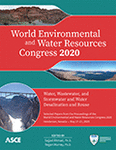World Environmental and Water Resources Congress 2020
Artificial Neural Networks and Adaptive Neuro-Fuzzy Models to Predict Remaining Useful Life of Water Pipelines
Publication: World Environmental and Water Resources Congress 2020: Water, Wastewater, and Stormwater and Water Desalination and Reuse
ABSTRACT
The U.S. water distribution system contains thousands of miles of pipes constructed from different materials, and of various sizes, and age. These pipes suffer from physical, environmental, structural, and operational stresses, causing deterioration which eventually leads to their failure. Pipe deterioration results in increased break rates, reduced hydraulic capacity, and detrimental impacts on water quality. Therefore, it is crucial to use accurate models to forecast deterioration rates along with estimating the remaining useful life of the pipes to implement essential interference plans to prevent catastrophic failures. This paper discusses a computational model that forecasts the RUL of water pipes by applying artificial neural networks (ANNs) as well as the adaptive neural fuzzy inference system (ANFIS). These models are trained and tested acquired field data to identify the significant parameters that impact the prediction of RUL. It is concluded that, on average, with approximately 10% of wall thickness loss in existing cast iron, ductile iron, asbestos-cement, and steel water pipes, the reduction of the remaining useful life is approximately 50%.
Get full access to this article
View all available purchase options and get full access to this chapter.
REFERENCES
Christodoulou, S., and Deligianni, A. (2010). “A neurofuzzy decision framework for the management of water distribution networks”. Water resources management, 24(1), 139-156.
Del Coso, C., Fustes, D., Dafonte, C., Nóvoa, F. J., Rodríguez-Pedreira, J. M., & Arcay, B. (2015). “Mixing numerical and categorical data in a Self-Organizing Map by means of frequency neurons”. Applied Soft Computing, 36, 246-254.
Fahmy, M., and Moselhi, O. (2009). “Forecasting the remaining useful life of cast iron water mains”. Journal of performance of constructed facilities, 23(4), 269-275.
Faraway, J. J. (2016). “Extending the linear model with R: generalized linear, mixed effects and nonparametric regression models”. Chapman and Hall/CRC.
Fares, H., and Zayed, T. (2010). “Hierarchical fuzzy expert system for risk of failure of water mains”. Journal of Pipeline Systems Engineering and Practice, 1(1), 53-62.
Feeney, C. S., Thayer, S., Bonomo, M., and Martel, K. (2009). “Condition assessment of wastewater collection systems”. Environmental Protection Agency (EPA). Washington, DC: US EPA.
Ghiasi, M. M., Arabloo, M., Mohammadi, A. H., and Barghi, T. (2016). “Application of ANFIS soft computing technique in modeling the CO2 capture with MEA, DEA, and TEA aqueous solutions”. International Journal of Greenhouse Gas Control, 49, 47-54.
Grigg, N. S., Fontane, D. G., and van Zyl, J. (2013). “Water distribution system risk tool for investment planning”. Water Research Foundation.
Montgomery, D. C., and Runger, G. C. (2010). “Applied statistics and probability for engineers”. John Wiley & Sons.
Najafi, M., and Kulandaivel, G. (2005). “Pipeline condition prediction using neural network models”. In Pipelines 2005: Optimizing Pipeline Design, Operations, and Maintenance in Today's Economy, pp. 767-781.
Nemeth, L. J. (2016). “A Comparison of Risk Assessment Models for Pipe Replacement and Rehabilitation in a Water Distribution System”.
Nicklow, J., Reed, P., Savic, D., Dessalegne, T., Harrell, L., Chan-Hilton, A., and Zechman, E. (2009). “State of the art for genetic algorithms and beyond in water resources planning and management”. Journal of Water Resources Planning and Management, 136(4), 412-432.
Osman, H., and Bainbridge, K. (2010). “Comparison of statistical deterioration models for water distribution networks”. Journal of Performance of Constructed Facilities, 25(3), 259-266.
Rogers, P. D. (2011). “Prioritizing water main renewals: case study of the Denver water system”. Journal of Pipeline Systems Engineering and Practice, 2(3), 73-81.
Rogers, P. D. (2011). “Prioritizing water main renewals: case study of the Denver water system”. Journal of Pipeline Systems Engineering and Practice, 2(3), 73-81.
Scheidegger, A., Leitao, J. P., and Scholten, L. (2015). “Statistical failure models for water distribution pipes–A review from a unified perspective”. Water research, 83, 237-247.
Scholten, L., Scheidegger, A., Reichert, P., and Maurer, M. (2013). “Combining expert knowledge and local data for improved service life modeling of water supply networks”. Environmental Modelling & Software, 42, 1-16.
St. Clair, A. M., and Sinha, S. (2012). “State-of-the-technology review on water pipe condition, deterioration and failure rate prediction models”. Urban Water Journal, 9(2), 85-112.
Suparta, W., & Alhasa, K. M. (2016). “Modeling of tropospheric delays using ANFIS”. Springer International Publishing.
Tavakoli, R. (2018). “Remaining Useful Life Prediction of Water Pipes Using Artificial Neural Network and Adaptive Neuro Fuzzy Inference System Models”, (Doctoral dissertation).
Tran, D. H., Ng, A. W. M., and Perera, B. J. C. (2007). “Neural networks deterioration models for serviceability condition of buried stormwater pipes”. Engineering Applications of Artificial Intelligence, 20(8), 1144-1151.
Tscheikner-Gratl, F. (2016). “Integrated Approach for Multi-Utility Rehabilitation Planning of Urban Water Infrastructure: Focus on Small and Medium Sized Municipalities”. innsbruck university press.
Wang, Y. (2006). “Deterioration and condition rating analysis of water mains”, (Doctoral dissertation, Concordia University).
Winkler, D., Haltmeier, M., Kleidorfer, M., Rauch, W., and Tscheikner-Gratl, F. (2018). “Pipe failure modelling for water distribution networks using boosted decision trees”. Structure and Infrastructure Engineering, 14(10), 1402-1411.
Yasseri, S. F., and Mahani, R. B. (2016). “Remaining useful life (RUL) of corroding pipelines”. In The 26th International Ocean and Polar Engineering Conference. International Society of Offshore and Polar Engineers.
Zangenehmadar, Z., and Moselhi, O. (2016). “Application of Neural Networks in Predicting the Remaining Useful Life of Water Pipelines”. In Pipelines 2016 (pp. 292-308).
Information & Authors
Information
Published In
World Environmental and Water Resources Congress 2020: Water, Wastewater, and Stormwater and Water Desalination and Reuse
Pages: 191 - 204
Editors: Sajjad Ahmad, Ph.D., and Regan Murray, Ph.D.
ISBN (Online): 978-0-7844-8298-8
Copyright
© 2020 American Society of Civil Engineers.
History
Published online: May 14, 2020
Published in print: May 14, 2020
Authors
Metrics & Citations
Metrics
Citations
Download citation
If you have the appropriate software installed, you can download article citation data to the citation manager of your choice. Simply select your manager software from the list below and click Download.
